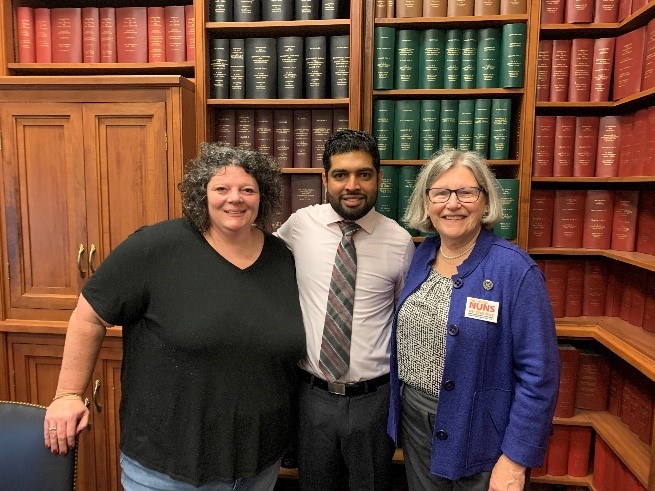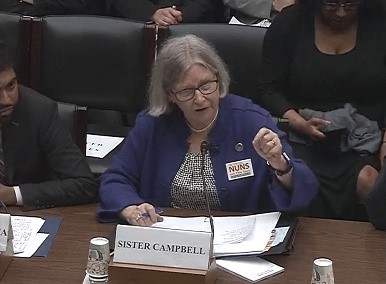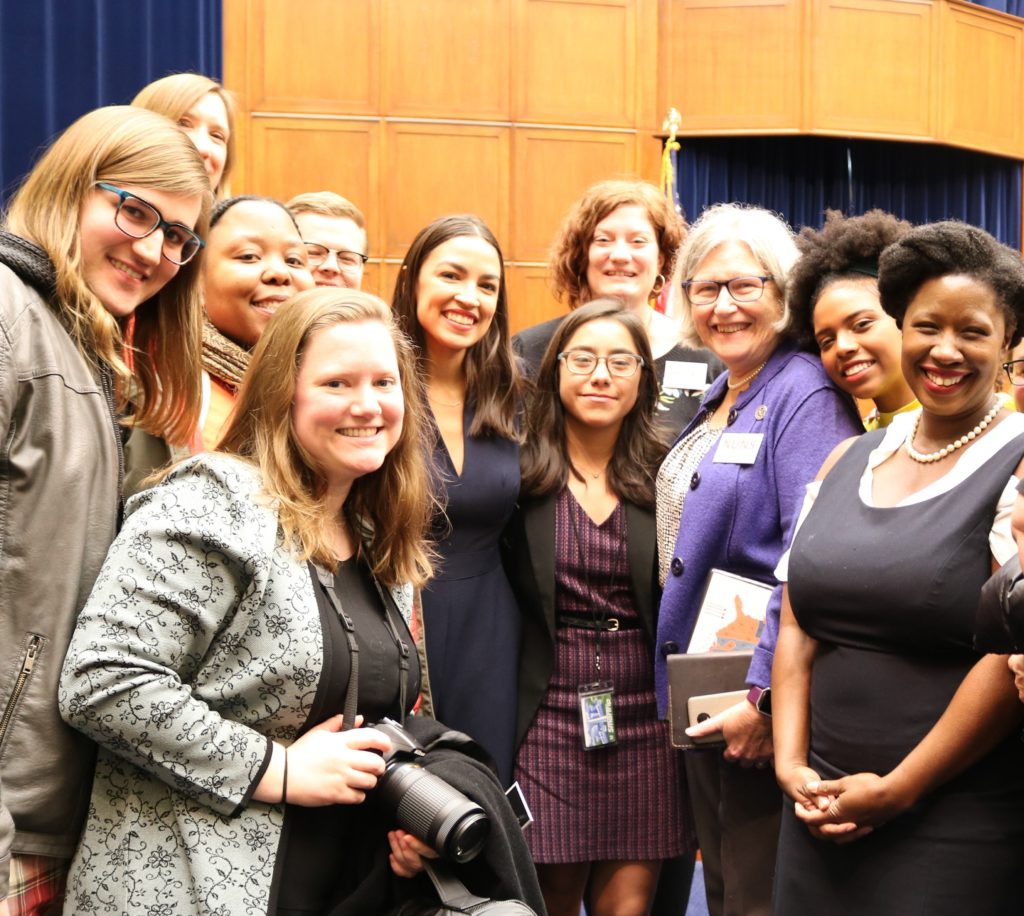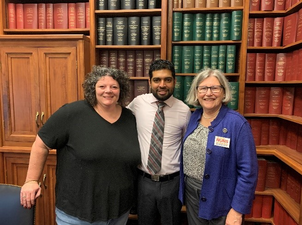
Bearing Witness to Harmful Policies on Capitol Hill
Child Poverty Would Worsen Under Trump Administration Proposals
Sister Simone Campbell, SSS and Sister Quincy Howard, OP
April 28, 2020
In February, the House Committee on Oversight and Reform held a series of four hearings over two days to examine the negative effects of regulations proposed by the Trump administration on children. The Oversight Committee invited Sister Simone Campbell, SSS to testify at the first hearing in the series, about how President Trump’s proposed change to calculating the federal poverty would harm children and families if it goes into effect. The remaining three hearings focused on: the Trump administration’s proposal to gut Fair Housing Accountability, proposed changes to Categorical Eligibility for SNAP (the Supplemental Nutrition Assistance Program), and the Trump administration’s proposal to undermine protections from Mercury Air Toxics Standards.
NETWORK was honored to participate and applauds the House Oversight Committee for holding these hearings. Using Chained CPI (Consumer Price Index) instead of regular CPI to calculate the poverty line — the proposed change that Sister Simone discussed — has been criticized by people of faith, advocates for children, and social justice organizations across the country. This hearing allowed Members of Congress to hear and discuss these concerns with experts, including Mr. Indi Dutta Gupta, the Co-Executive Director of the Georgetown Law Center on Poverty and Ms. Amy Jo Hutchison, an organizer with the Healthy Kids and Families Coalition, West Virginia, as well as Sister Simone Campbell.
 While Mr. Dutta Gupta offered an economic argument and Ms. Hutchinson shared her lived experiences of raising children in a low-income family, Sister Simone’s testimony provided a moral perspective on this change, with an emphasis on how it would affect our nation’s most vulnerable children.
While Mr. Dutta Gupta offered an economic argument and Ms. Hutchinson shared her lived experiences of raising children in a low-income family, Sister Simone’s testimony provided a moral perspective on this change, with an emphasis on how it would affect our nation’s most vulnerable children.
Here is a portion of Sister Simone’s testimony to the Committee:
Protecting children is about caring for the common good — today and into the future. Thanks to modern understanding of human development, we have a heightened awareness of how children are uniquely vulnerable to a variety of factors — physically, emotionally, psychologically. Grave, potentially lifelong impacts can result from malnutrition as children grow. Exposure to chemicals and stressors as children develop inhibit their health. Traumatic experiences and encounters early childhood can create lifelong scars. Children are also intensely responsive to the emotional well-being of their caretakers and are formed by their living situation and immediate surroundings. In so many ways, children are more susceptible to physical and psychological stressors and less able to respond or understand their experiences.
The Role of Government:
The Trump administration’s choices — reflected in the regulatory rule-changes under scrutiny in these oversight hearings — make it harder for families to survive and to support thriving children. While the rules under review in this series of oversight hearings may seem like technical decisions, they are, at their core, moral decisions and must be treated as such.
This proposed change in the calculation of the Consumer Price Index is based on the middle and upper class experience of “shopping around” to find the best price. It also is based on the capacity of wealthier families to buy in bulk. Lower income families have neither the extra money to buy a large quantity nor the space in cramped rental residences to store extra supplies. Creating a rule that incorrectly assumes those experiencing poverty have the same experiences as wealthier people betrays the Constitutional mandate to promote the general welfare.
 The OMB’s proposal to change how poverty is measured is not only misguided, but is immoral. I am here to emphasize the lived reality of people in poverty and how this rule change not only ignores their reality, but would further sideline working families and the children they struggle to care for. Choosing to apply the Chained-CPI for setting poverty thresholds would not only further skew known shortfalls of the official CPI, but also would increasingly mask the extent to which families in the United States — and particularly children — suffer in poverty.
The OMB’s proposal to change how poverty is measured is not only misguided, but is immoral. I am here to emphasize the lived reality of people in poverty and how this rule change not only ignores their reality, but would further sideline working families and the children they struggle to care for. Choosing to apply the Chained-CPI for setting poverty thresholds would not only further skew known shortfalls of the official CPI, but also would increasingly mask the extent to which families in the United States — and particularly children — suffer in poverty.
Poverty, the Lived Reality:
It is tempting to lump together all kinds of people to frame “poverty” in stereotypes. But people living in poverty are diverse and the challenges they face are varied. In 2019, NETWORK held 17 roundtables in rural communities in 16 states. What we learned was that these rural communities have no options for shopping.
In Tutwiler, Mississippi we were told that there was only the Dollar General and it had no fresh fruits and vegetables. If you wanted something else, there were no restaurants, fast food places, or farmers markets. There was only “gas station chicken”—fried chicken prepared at the gas station. There were no options or choices. Outside of Tiffin, Ohio, the story was the same. The rural residents referred to their Dollar General as the “shopping mall” because it carried a bit of everything and was their only option. In rural northern California, we learned that the casino was even beginning to stock food items for surrounding residents since the casino provided the only transportation option in several surrounding counties. It was the only way for many families to get somewhere they could purchase food. These rural residents had no store, no choice.
Conclusion:
We will never address these families’ struggles by masking the true extent of poverty in our nation. My faith tells me that both individuals and our governments have a responsibility to act for the common good. Central to this responsibility is protecting and supporting the most marginalized in our society. We should be investing in our nation’s children, not amplifying the crushing socioeconomic burdens of so many who are pushed into poverty.
NETWORK Responds to the Committee’s Questions
Following Sister Simone’s testimony, NETWORK submitted the answers below to the Oversight Committee in response to questions asked during the hearing. These questions and responses provide a look into how our nation’s elected officials are thinking about child poverty in the U.S.
Question: The 2020 poverty guideline issued by the Department of Health and Human Services is $26,200 for a family of four. Is this amount sufficient to meet families’ needs? Why or why not?
Answer: Under no circumstances is this income sufficient — at least not in the U.S. The Massachusetts Institute of Technology developed the Living Wage Calculator to estimate the cost of living in a community or region based on typical expenses. The tool helps determine a local wage rate that allows residents to meet minimum standards of living for their basic needs.
In 2019, Yahoo! Finance rated the top 25 least expensive cities to live in the U.S. and rated the Texas city of Harlingen as the cheapest place, overall. [i] According to the MIT Living Wage calculator, a single parent with three children living in Cameron County (where Harlingen is located) would need to earn $65,291 before taxes to cover their basic expenses.[ii] A family of three with both parents working would need to earn $50,509 to cover their expenses. This example alone demonstrates how out-of-sync our federal measures have become in light of the reality of living costs.
Question: In your testimony, you focused on the long-term effects that poverty has on children. How do children experience poverty differently from adults?
 Answer: The contextual factors of poverty amplify the experience of children growing up poor. The neighborhoods in which children grow up shape many aspects of their adult lives, including life expectancy, how healthy they will be, and how much money they will earn.[iii] Nearly 10 million U.S. children live in low-opportunity neighborhoods, with limited access to good schools, parks, and healthy food and often experience discrimination as a result. Simply being born in these pockets of poverty puts these kids at a stark disadvantage. While adults may move through periods of hardship and bounce back, the experience for children can be formative.
Answer: The contextual factors of poverty amplify the experience of children growing up poor. The neighborhoods in which children grow up shape many aspects of their adult lives, including life expectancy, how healthy they will be, and how much money they will earn.[iii] Nearly 10 million U.S. children live in low-opportunity neighborhoods, with limited access to good schools, parks, and healthy food and often experience discrimination as a result. Simply being born in these pockets of poverty puts these kids at a stark disadvantage. While adults may move through periods of hardship and bounce back, the experience for children can be formative.
The well-being of a child cannot be separated from the well-being of their household and their family unit. Children develop in an environment of relationships that begin in the home and they are uniquely sensitive to instability, disruption and the emotional well-being of those around them. I practiced family law for 18 years in Oakland California serving most of the low-income, high-conflict clients in our county. As such I learned that the single biggest cause of the breakup of a marriage is economics. Financial stress and the inability to pay the bills on time puts tremendous stress, guilt, and anger into any relationship. One poll from the Harvard School of Public Health found that more than 4 in 10 people “under a great deal of stress in the last month” reported that this stress made it harder to get along with family members (45%) and prevented them from spending time with family members (44%).[iv] For children growing up in a low-income home or neighborhood, caretakers with chronic or acute financial anxiety can further destabilize the environment and give rise to toxic stress, which can have lifelong impacts on children.[v]
Question: You have traveled across this country and seen poverty in different areas. What would you say are ways that poverty is different or similar across the nation?
Answer: Regardless of where they live, families living in poverty have something in common: their lives are regularly afflicted by obvious hardships and by invisible barriers. Across the board, U.S. families experience poverty as a relentless, crushing reality and a constant state of anxiety. People living in poverty in the U.S. share in their lack of access to needed goods and services and lack of options in decision-making. Nevertheless, rural and urban realities of poverty differ in their manifestations. Rural poverty has the added burden of isolation and loneliness and lack of internet access. Childcare—and especially affordable childcare—is even less available in rural communities than in urban settings. Health care is challenging in both settings, but access to a pediatrician in rural communities is unheard of. Finally, mental health practitioners are simply absent in most rural communities.
Question: The Trump Administration’s proposal to apply the Chained CPI to the Poverty Line would cut many individuals from government programs, but some Republican members have touted it as helping to curb an ‘expansion of the welfare system.’ How would you respond?
Answer: This false narrative is tired and dangerously misleading. Temporary Assistance for Needy Families (TANF) passed in 1996 as welfare reform and basically did away with cash assistance for struggling families. The amount appropriated in 1996 is approximately the same dollar amount appropriated today. There has been no increase for inflation or increase in amount to reflect the needs of struggling families, even during the Great Recession.
TANF was meant to have many supports for parents to go to work. There was to be funding for education, childcare, transportation, and much more. None of this materialized because Congress never fully funded their promise. The only thing that was done is cutting cash aid.
Any expansion of the “welfare system” in recent years is the result of formula-based programs responding to flat wages and growing income inequality. SNAP and Medicaid have become the actual safety net for allowing children to eat and get needed health care as their parents struggle in an increasingly perilous low wage labor market. The real spending value of SNAP benefits has actually gone down in the past several years so claiming “expansion” of the program is disingenuous and misrepresents the root cause of more need.
The short answer is that if we care about our future as a nation, we will ensure that our children eat and that they have access to health care. It is the least that we can do.
Question: How common is abuse by adult family members of programs like Free and Reduced Lunch programs or SNAP that are intended for children? Are there ways that we can better ensure these programs benefit children in need?
Answer: I was shocked by this question from Ranking Member Meadows. It evidenced his disconnect from the actual lived reality of children participating in the Lunch programs. His willingness to focus on a hypothetical scenario and the judgement built into that scenario is deeply disturbing. Rather than prioritize and lift up the benefits to children, he is focused on a misguided narrative that demonizes poor parents as prone to taking advantage of or neglecting their children. Any instance of this type of abuse of benefits in which a parent funnels food assistance away from their hungry child clearly could not stand.
I was told by a father in Milwaukee, Wisconsin that it might be okay for a parent to eat once or twice a day, but growing children (especially his 14-year-old boy) needed much more than that. I have also talked with parents in rural Iowa who shared the same concern and were so grateful for the lunch program for their growing children. This is the TYPICAL response of parents and Representative Meadows would do well to talk with them.
Parents — even parents struggling financially — can be trusted to prioritize the well-being of their own children. This question is the quintessential example of how out-of-touch lawmakers make classist judgments about the motives and accountability of people — and parents — struggling in poverty.







